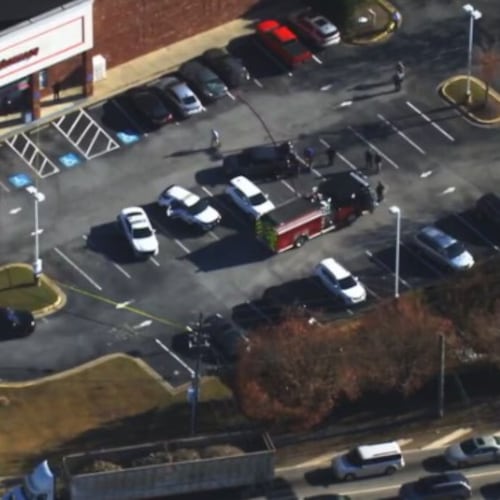Outside the beat-up convenience store in the woebegone neighborhood are competing memorials, two heaps of weather-beaten teddy bears and deflated balloons.
The arrangement out front of JVC Grocery is for Obie Phillips, a 62-year-old neighbor gunned down in October by a passing car as he walked from the store one night. The one along the building's side is for Demetrius Davis, a 22-year-old ambushed Nov. 22 by a probable gang member toting an AK-47. That one was caught on security cameras.
The store at 1029 McDaniel Street in the Pittsburgh community has become a symbol for societal breakdown. It’s an epicenter for so-called black-on-black crime, a place where young guys settle grievances known only to themselves.
The address became nationally infamous in 2012 when three young thugs sucker-punched, then beat the tar out of a gay kid and had the good sense to film their crime and post it for all to see, which landed them in prison. The thug element has appropriated the address as a badge of misguided courage and belonging. Yo, Jack City 1029!
The latest killing — a brazen assassination by criminals who openly waited outside for their victim — has the community calling for the business, locally known as the Pink Store, to be turned into a police precinct. That would be fitting, said Pierre Gaither, operations manager for the Pittsburgh Community Improvement Association, because the gang members have seen it as their headquarters.
Talk of the uneasy relationship between police departments and black neighborhoods is everywhere in the aftermath of cops killing black men in Ferguson, Mo., and Staten Island, NY. Lots of black folks, especially in poor communities, say they see cops acting like an occupying force.
But in Pittsburgh, a historic black community just south of downtown, lots of residents see the rootless and dangerous young criminals as the occupying army, and with good reason. Crime in the patrol beat around the store is up 12 percent this year, with aggravated assaults up 46 percent (there have been 67) and residential burglaries up 31 percent (there have been 98). But the surge is merely a matter of degree; 1029 has been an incubator of trouble for ages.
“Police presence is definitely a big deal here, people want to see more of it,” said Gaither. “The relationship with APD has grown tremendously with residents. It hasn’t always been that way. A lot of people didn’t trust the police.”
Many still don’t, although there’s a grudging acceptance that they’re the only thing keeping the place from complete mayhem.
Deion Howell, a 31-year-old who grew up in Pittsburgh, said troublemakers, most of whom he doesn’t recognize, have tainted how people see their neighborhood.
“We’d like to get it back to how it was,” he said. Police are part of the answer, he said, although a bit hesitantly. “They iffy; they harass the people and they label you,” he said, quickly adding, “but they patrol it pretty good.”
Outside 1029 on a recent afternoon, police Maj. Jeff Glazier stood on the corner he is intent on commandeering.
Glazier, a lantern-jawed Notre Dame grad, recently felt just a touch of the fear and foreboding that’s imprinted in residents’ DNA. He walked into 1029 and then noticed two young men saunter in after him. He admits it: He was a bit unnerved.
“And if I don’t feel comfortable; the citizens won’t,” he said. Darn right. If a top-ranking police official gets the heebie-jeebies, then that location is just about haunted. Time for an exorcism.
After the latest killing, Glazier had the city drag those orange lane-closure barricades to the curbs alongside the store. They prevent cars from sidling up to the business. And send a message.
“Those who control the public space control the quality of life,” said Glazier, who is commander of Zone 3. “And I was convinced that the wrong people were controlling that space.”
Glazier has a conundrum, though: He oversees a zone with 13 beats, but on any given shift he has just 20 to 30 cops to patrol them. Right now, 1029 is the focus and will get more than its share. Which means that other areas will get less.
It’s like playing Whac-a-Mole: You slam the mallet down, and the varmints pop up elsewhere. This forlorn corner isn’t even the worst place in his zone for crime numbers.
“But in terms of important symbolic value, in making a statement, then this is one of the more important places in Zone 3,” Glazier said. “And you can only take back one corner at a time.”
Glazier was paying a visit to 1029 accompanied by city zoning officers, a fire marshal and state food inspectors just to get the store on notice that they are getting the big official looksie. Inside, inspectors found baby formula they believe was stolen, loose cigarettes for sale, a freezer blocking the exit and products past their due date.
The major is hoping the added attention will get the owner to help the police more, to discourage loitering, to hire security guards, to set a tone around the store that illegal activity won’t be tolerated.
Easier said than done, said Sammy Torres, who works in the store and said he once owned it until he lost a small fortune. “This neighborhood is bad, believe me,” he said.
“These young guys are dangerous. They’re a big, big problem,” he said from behind the meat counter. “We throw them out of the store; they come back. The only time we have peace in the store is when the police are sitting out there.”
Ernest McKenzie, 60, was standing outside with an energy drink, talking loudly on a cell phone. He lives next door, where the owner of the decrepit residence lets him stay to keep an eye on the place.
Of 24 houses in a two-block stretch of McDaniel Street, only six have people living in them. It’s a lack of eyeballs on the street, a lack of regular human discourse that allows the turmoil to flourish. The punks sense a vacuum, and they fill it.
“Ain’t nothing wrong with that store,” McKenzie said. “It’s these young guys. They got no respect.”
McKenzie was standing on the same spot a couple years ago with two friends when a car came by and sprayed the front of the building with bullets. He stood terrified behind a telephone pole while his two friends went down in heaps. One is still paralyzed.
“Here today, gone tomorrow,” he told news crews at the time.
Neighbors hope it won’t be the same with police.
About the Author
The Latest
Featured



